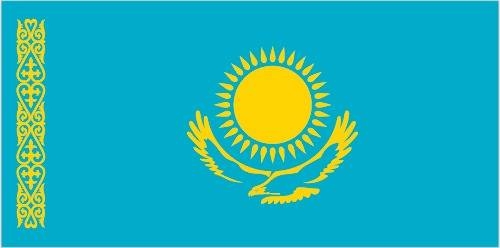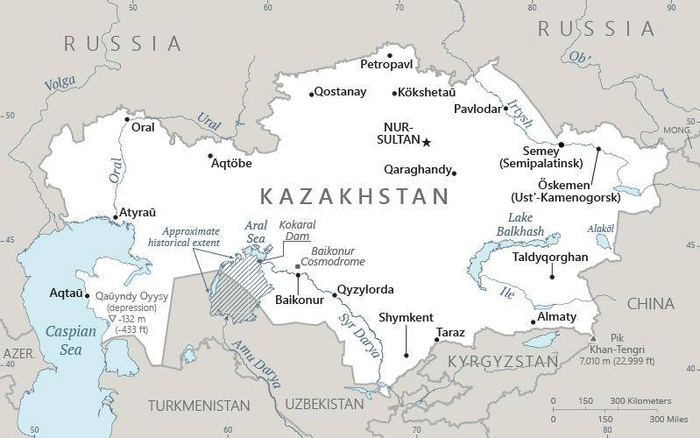147 Kazakhstan

A gold sun with 32 rays above a soaring golden steppe eagle, both centered on a sky blue background. The hoist side displays a national ornamental pattern “koshkar-muiz” (the horns of the ram) in gold. The blue color is of religious significance to the Turkic peoples of the country, and so symbolizes cultural and ethnic unity. It also represents the endless sky as well as water. The sun, a source of life and energy, exemplifies wealth and plenitude. The sun’s rays are shaped like grain, which is the basis of abundance and prosperity. The eagle has appeared on the flags of Kazakh tribes for centuries and represents freedom, power, and the flight to the future.
Flag courtesy of the CIA World Factbook

Map courtesy of the CIA World Factbook

The Hazrat Sultan (Holy Sultan) Mosque in Nur-Sultan is the largest mosque in Central Asia. Built on the bank of the Esil River, the building was constructed between 2009 and 2012 in the classic Islamic style using traditional Kazakh ornaments. At 110, 000 sq m (11 hectares; 27 acres), the mosque can accommodate up to ten thousand worshipers.
Photo courtesy of the CIA World Factbook
Government
According to Britannica, Kazakhstan’s first post-independence constitution was adopted in 1993, replacing the Soviet-era constitution that had been in force since 1978; a new constitution was approved in 1995. The 1995 constitution provided for legislative, executive, and judicial branches of government dominated by a strong executive. Amendments to this constitution in 2017 reduced executive authority and granted the legislature additional checks on executive power. Additional amendments in 2022 further reduced presidential power, including the reestablishment of a constitutional court and the guarantee of greater independence for local leaders.
Kazakhstan is a unitary republic with a bicameral legislature consisting of a Senate and an Assembly (Mazhilis). Working jointly, the two chambers have the authority to amend the constitution, approve the budget, ratify treaties, and declare war; each chamber also has exclusive powers. Legislators serve four-year terms. Two members of the Senate are elected from each oblast and major city by all legislative members of that administrative unit, with the exception of several appointed by the president. Ninety-eight members of the Assembly are elected from population-based constituencies by universal adult suffrage.
The president is the head of state and is directly elected for a maximum of one seven-year term. The president appoints the prime minister and other ministers of the cabinet, as well as the chairperson of the National Security Committee, most of whom are then confirmed by the legislature; the foreign minister, minister of defense, and minister of internal affairs are appointed without requiring legislative consent. The president serves as commander in chief of the armed forces and is responsible for the country’s foreign relations.
The highest judicial body is the Supreme Judicial Council, and there also are a number of lower courts; a Constitutional Court, the members of which are appointed by the president and legislature, reviews constitutional questions. Judges serve life terms and are appointed by the president, with those of the Supreme Court also subject to confirmation by the legislature.
The constitution specifies a number of rights of the citizens of Kazakhstan, including freedom of speech, religion, and movement. Citizens have the right to work, to own property, and to form trade unions. Despite the democratic language in the constitutions of 1993 and 1995, in the early years of independence Kazakhstan became increasingly authoritarian. The country’s first parliamentary elections (1994) were declared illegal by what was then the Constitutional Court. This precipitated the drafting of the 1995 constitution, which expanded the already substantial powers granted to the president by the 1993 constitution. In 2017 a set of amendments reduced the role of the presidency and granted greater authority to the parliament. Amendments enacted in 2022 also advanced the independence of the parliament and the judiciary from the presidency.
Civil Aviation Committee
The state institution Civil Aviation Committee of the Ministry of industry and infrastructure development of the Republic of Kazakhstan is a Department of the Ministry of industry and infrastructure development of the Republic of Kazakhstan that performs regulatory, implementation and control functions, as well as participates in the implementation of the Ministry’s strategic functions in the field of civil aviation.
Airspace
SkyVector – Google Maps – ADS-B Exchange
ICAO countries publish an Aeronautical Information Publication (AIP). This document is divided into three parts: General (GEN), En Route (ENR) and Aerodromes (AD). ENR 1.4 details the types of airspace classes they chose to adopt from classes A through G.
Drone Regulations
Kazakhstan has introduced a registering drone procedure
Advanced Air Mobility (AAM) Regulations & Policies
None found by the author.
However, should you, the reader, happen to stumble across something to the contrary, please email the author at FISHE5CA@erau.edu and you may be mentioned in the ACKNOWLEDGEMENTS section of this book by way of thanks for contributing to this free eBook!
Advanced Air Mobility (AAM) News
2025 – Kazakhstan operator places order for Joby air taxis
2025 – EHang, Allur Group partner on urban air mobility
Short Essay Questions
Scenario-Based Question
You have been hired by a Drone Startup Company. Your boss has immediately assigned this job to you.
They need you to prepare a one-page memo detailing the legalities of using a drone to film the Mosque, pictured above.
They need you to mention any national laws and local ordinances.
They specifically want to know what airspace (insert pictures) you will be operating in and whether or not you need an airspace authorization.
Does it matter whether or not you are a citizen of the country?
Lastly, there is a bonus for you if, as you scroll through this chapter, you find any typos or broken links!
Short Essay Questions
- What are the drone categories?
- How is registration addressed?
- How is remote ID addressed?
- What are the model aircraft rules?
- What are the commercial drone rules?
- Are there waivers or exemptions to the rules? If so, for what?
- Would you share a link to an interactive airspace map?
- How is BVLOS addressed?
- How can you fly drones at night?
- How can you fly drones over people?
- Where do you find drone NOTAMs?
- What are the rules for drone maintenance?
- What are the rules for an SMS program?
- What are some unique rules not mentioned above?
- What are the C-UAS rules?
- What are the AAM rules?

